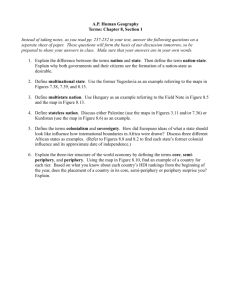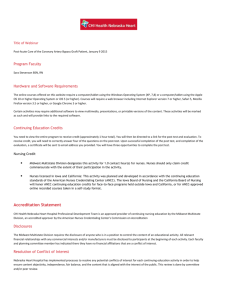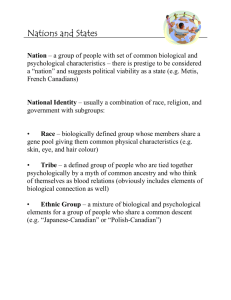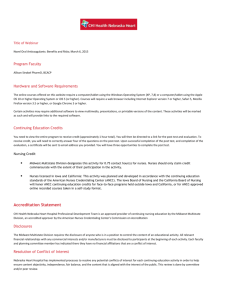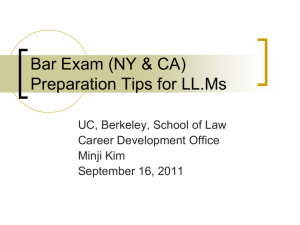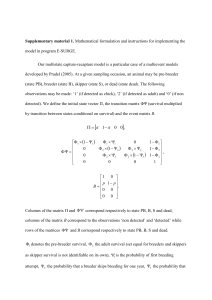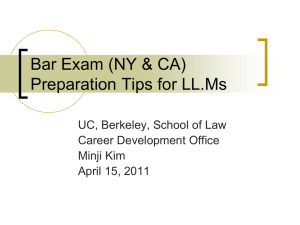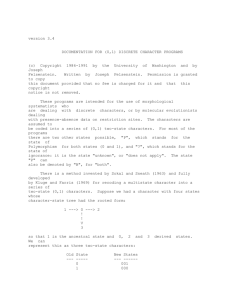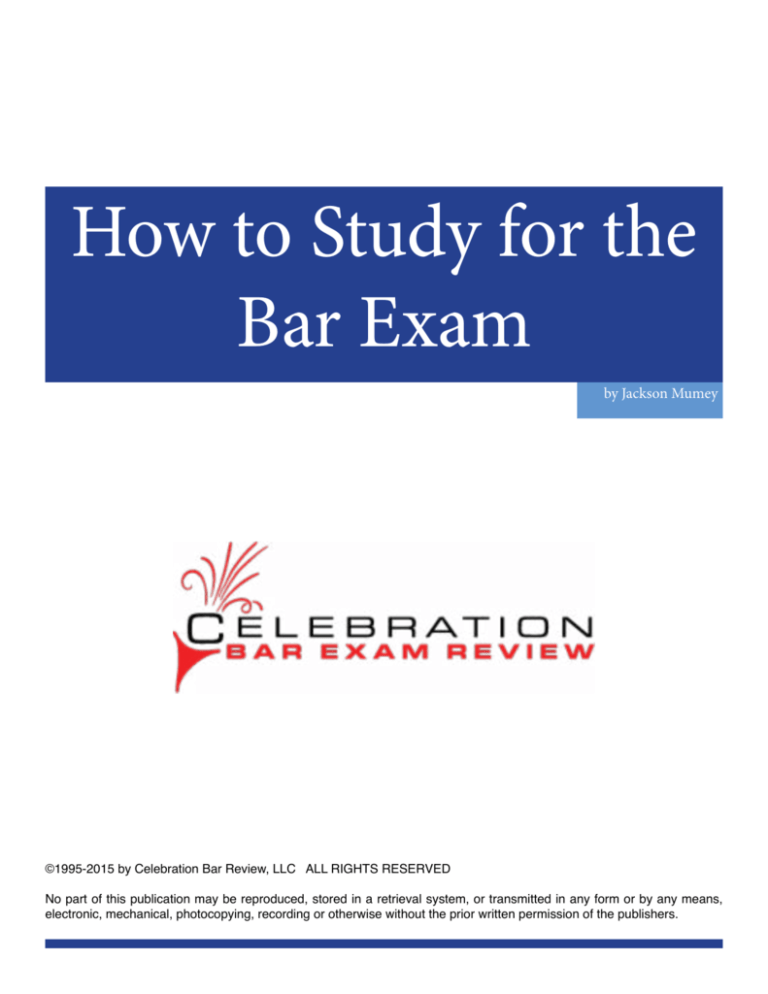
How to Study for the
Bar Exam
by Jackson Mumey
©1995-2015 by Celebration Bar Review, LLC ALL RIGHTS RESERVED
No part of this publication may be reproduced, stored in a retrieval system, or transmitted in any form or by any means,
electronic, mechanical, photocopying, recording or otherwise without the prior written permission of the publishers.
Table of Contents
A Word of Introduction3
Explanation of the Multistate Bar Exam4
How to Study for the Multistate Bar Exam 5
Exam Format of the Multistate Bar Exam9
Some Myths About Studying for the Bar Exam
10
Personal Study Guide Sample - 201512
A Word of Introduction
Welcome! We’re Jackson and Sara
Mumey, and together we’ve been
preparing students to take their bar
exams for over 2 decades. Since 1995
we’ve operated as Celebration Bar
Review. It’s a family-run business that
takes pride in offering a quality course
with personal service and attention.
Sara runs the office and coordinates
our production staff and vendors.
Jackson coordinates our editors
and lecturers and is responsible for
course content. He also does all of the
personal mentoring.
When we first began the bar review,
we only had a handful of students.
Then, as now, we didn’t advertise but
relied on word of mouth and our web
pages. Today, our course has grown
ten-fold from the early years and
each exam we are forced to turn away students who wish to study with us. It’s a nice problem to have!
In this free eBook, we want to share some of the ideas and concepts that have proven successful for our thousands
of students over the years. We know you’ll find them helpful!
In the pages that follow, you’ll find a description of the Multistate Bar Exam (MBE), some tips on how to study for
the MBE, information about various State Exams and a sample MBE Study Guide to follow.
Specific course instruction and state exam preparation is available for our registered students only.
For information on how to join our course, please visit our website: www.celebrationbarreview.com
or email: jackson@celebrationbarreview.com
or call Jackson directly at (864) 365-6083 We will always reply to your emails or phone messages within just a few
hours (often right away!). Go ahead, try it now. You’ll be surprised at who answers the phone or responds to your
email.
Before you begin, please take a few minutes to watch this video, titled “Forget What You Know About Good Study
Habits.” You may be surprised to find that what you thought about the “right” way to study for the bar is ALL
WRONG!
How to Study for the Bar Exam
Page 3
Jackson Mumey
Explanation of the Multistate Bar
Exam
Beginning with the 2015 exams, the Multistate Bar Exam consists of 200 four-option
multiple-choice questions prepared by the American College Testing Service for the
National Conference of Bar Examiners. Of the 200 questions, 190 are graded and 10
are “pre-test” questions that do not count in the grade. The pre-test questions are not
identified as such in the exam. Candidates answer 100 questions in the three-hour
morning session and the remaining 100 questions in the three-hour afternoon session.
Starting in 2015, there will be a roughly equal number of questions in torts, contracts
and sales, constitutional law, criminal law and procedure, evidence, property, and a
new subject: Federal Civil Procedure and Jurisdiction. Specified percentages of the
questions in each subject are devoted to particular subtopics of those subjects. For example, nine of the evidence
questions test the hearsay rule and its exceptions. The Celebration Bar Review materials are designed to reflect the
relative weights of the topics tested.
In 2015, the MBE changes with the addition of Federal Civil Procedure as a 7th topic. Our materials are updated to
reflect those changes and as a Licensee of the National Conference of Bar Examiners, we’ll have all of the questions
and answers that are available as they are released.
Grading the Multistate Bar Examination
The candidate is first given a “raw score,” i.e., the number of questions answered correctly out of the 190 that count
towards grading. No deduction is made for wrong answers, so it is important to answer all questions, even if the
answer is a random guess. The raw score is then adjusted by adding points to achieve the “scaled score.” The
number of points added is determined by a complex formula which compares the difficulty of the current exam
to the difficulty of the July 1973 Exam. The comparative performance of students on 60 “control” questions, 30 of
which have been given on a previous February examination and 30 of which have been given on a previous July
examination, form the basis for determining the difficulty of each exam. Past grading practice indicates that you
can expect from 10 to 18 points to be added to your raw score to determine your scaled score.
Combination of the Multistate Grade with Local Exam Grade to Determine Passing Scores
The National Conference of Bar Examiners does not prescribe the score which an applicant must obtain on the
Multistate Bar Exam in order to pass it or the entire bar exam. Each state determines both the way in which the
applicant’s Multistate score will be combined with the score on the local portion of the exam, and the minimum
passing score. The next chapter of this Study Guide describes the procedure that this jurisdiction uses.
How to Study for the Bar Exam
Page 4
Jackson Mumey
How to Study for the MBE
Overview of the Multistate Approach
Phase 1: Learning the Law - The first emphasis of the course centers on mastering the principles of Multistate law
which will allow you to achieve a satisfactory score on the Multistate Bar Exam. In order to accomplish this, you
will need to study the substantive law as it is presented in the text materials and/or the lectures, and work through
the Multistate questions as they are presented in the software or questions volumes.
Phase 2: Review and Examination Practice - The course will allow you to test your abilities as to the substance
and the techniques necessary to pass the Multistate Bar Exam. You should first review your performance on
the questions answered up to that date to ensure that you have the knowledge and skills necessary to pass the
Multistate Bar Exam. Sample Multistate exams will also be presented in the format of the actual Multistate Exam.
Your performance on the questions will either assure you that you have the requisite knowledge and skills, or will
indicate where you should best spend the remaining study time to ensure that you will acquire that knowledge and
skill.
All of these elements are described in further detail below.
Phase 1: Learning the Law
The centerpiece of good Multistate study is the Celebration Bar Review method of Read/Lecture/Practice. For each
subject, the best way to learn is to read the outline material first, then watch or listen to a lecture on that material
and then practice with sample questions and answer explanations.
The Recommended Method
A good approach to test preparation should be designed to provide flexibility so that you can tailor the course to
suit your own special needs. Thus, it is important to give some guidance as to the various approaches that you may
take in utilizing the materials provided. The Recommended Method should best suit the needs of the vast majority
of students. This method is appropriate to all students except those who have severely restricted schedules or those
who already have a significant background in the subjects on the Multistate Bar Exam. (Such students should see
the method outlined below in “Alternative 1: the Expedited Method.”)
You will need to lay the substantive groundwork before you begin to work on the questions. Ideally, you should
read the outline, watch or listen to the lecture and then review the notes on difficult areas before working on the
questions.
Once you have prepared for each subject, you should begin as soon as possible thereafter to work on the questions
in that subject. In order to take maximum advantage of the Recommended Method, you should always pick your
answer to each question and then read the analysis of your answer before proceeding to consider the next question.
If you got the question right, you should quickly read why you got the question right (without reviewing the
How to Study for the Bar Exam
Page 5
Jackson Mumey
incorrect choices to that question) and then proceed to the next question. However, if there was a close second
choice for you, you should probably review why that choice was wrong. If you got the question wrong, you should
try the question again until you get it right. This way you will take full and efficient advantage of the opportunity
to learn from any mistakes that you have made.
Whatever you do, you should not skip questions or you would be completely unfamiliar with some issues that you
must understand in order to succeed on the Multistate Bar Exam.
The Expedited Method
You may choose instead to proceed directly to the questions, especially if you feel that you already have a sufficient
background in the subjects tested on the Multistate Bar Exam. Then, you can use the organized approach of the
Expedited Method to test your knowledge, and to teach you the law that you didn’t already know. The disadvantage
of this method is that the predictive value of this phase of the question practice will be diminished. Your scores
will be negatively affected by the fact that you have not done the usual substantive groundwork. Still, there are
practice exams which will be available to you and which should have true predictive integrity.
Phase 2: Review and Examination Practice
Review
In order to take full advantage of the Recommended method, it is important not only that you practice on questions,
but that you review and analyze your performance.
In general, we recommend that students proceed through their initial question practice on all six subjects before
they return to review their performance on any one subject. (Otherwise, it is entirely too easy to get bogged down,
when continued progress is key to completing the course successfully.)
Once you have determined in which categ10ories your performance was insufficient, you will need to brush up on
your understanding of the law. First of all, you can read the applicable text, and/or Nutshells of Law. Then, you
should proceed to review any questions that you got wrong the first time, and do any questions that you have not
already done.
At the very least, you should review the Multistate questions you got wrong in the final weeks before the bar exam.
This will focus on your substantive and exam-taking weaknesses and sharpen your edge to take the actual Exam.
This is perhaps the most critical step of your final preparation for the actual Multistate Bar Exam. You should
first try to analyze why you answered each question incorrectly in the first place. Most commonly, it is because
you did not know the applicable substantive law. You should have already corrected this mistake by reviewing the
applicable law. If you knew the law but answered the question incorrectly because you misread the question or
did not understand the way the Examiners used the distracters, you should try to learn from your mistake so that
you will not make it again. Occasionally, you will answer incorrectly because the legal conclusions you reached on
questions involving a judgment call were different from those the Examiners believed were correct. This inevitably
occurs on some of the questions on the Multistate Bar Exam and should not be of concern; a few problems with
judgment calls will not seriously affect Multistate scores. Remember that you can get about one out of every three
questions wrong on the Multistate Bar Exam and still pass it quite handily.
How to Study for the Bar Exam
Page 6
Jackson Mumey
Examination Practice
After using the Recommended or Expedited Approach to learn the law as it is tested on the Multistate Bar Exam, it
is important to practice your skills on some sample practice exams, which will present the questions in the format
of the actual Multistate Bar Exam. These exams should not be taken until you have completed the learning module
part of the question practice.
You should use actual released MBE tests (such as those included in the Celebration Bar Review course). These
tests should be taken near the end of your study. The exams include the scaled scoring which was applied to all bar
takers, and as such, are the best predictor of your performance on the MBE. You should strive for a minimum raw
score of 130 questions answered correctly out of the 200 questions.
Wherever possible, take these exams under true exam conditions. You should try to do each set of questions as
they are presented on the actual Multistate Bar Exam -- 100 questions in each 3-hour session.
Creating Nutshells of Law
It’s helpful to reduce your learning to small “nutshells.” We’ve done that work already in our course, but you can
create your own Nutshells of Law by summarizing the principles of substantive law which most often govern the
correct answer to Multistate questions. When completing questions, you should try to fix these Nutshells in your
mind and observe how they determined the answer to the questions. These rules of law will likely control the
answers to more than half of the questions which you will encounter on the actual Multistate Bar Exam. As you
near the end of your preparation, you should again review your Nutshells of Law and commit them to memory.
When your decision between two tough choices depends on knowing a rule of law, it is important to have that
knowledge at your fingertips.
Conclusion
By diligently preparing the assigned questions and intelligently assessing why questions were answered incorrectly, you will find that your Multistate skills improve substantially during the course of your study. You can
continue to improve those skills by following the advice given in this eBook until you reach a level of proficiency
which will enable you to pass the Multistate Bar Exam. This proficiency is easily and accurately measured when
testing is in the multiple-choice format. Some students will have to work harder than others to achieve the required proficiency, but all the tools are here and any law school graduate can be successful if the required effort is
expended.
Taking the Multistate Bar Exam requires intense concentration for a six-hour period. The ability to read carefully and think clearly during the exam is essential to success. Therefore, candidates should arrive at the test site
well rested. You should not study the day before the exam; instead, you should rest and relax. You should be
sure to arrive at the exam site on time. If necessary, stay at a nearby hotel, rather than risk a long drive the morning of the exam.
There is no easy way to conquer an exam as difficult and comprehensive as the Multistate Bar Exam except
through carefully directed hard work over a sustained period of time. This program should help you through this
ordeal successfully.
How to Study for the Bar Exam
Page 7
Jackson Mumey
Each jurisdiction has their own rules for the state part of the exam. Many states use individual tests that may
include essays, performance tests, multiple choice questions and short-answer questions. Some states use the
Uniform Bar Exam (UBE) or the Multistate Essay Exam (MEE) rather than a state-specific test.
Because of the variety of jurisdictions and tests that are offered, no single approach can be described in this book.
Instead, below you will find links to our free video lectures that explain the tests of 6 major states plus the Uniform Bar Exam and Multistate Essay Exam:
California
Florida
Georgia
New Jersey
New York
Texas
UBE/MEE
CA First Year Baby Bar
How to Study for the Bar Exam
Page 8
Jackson Mumey
Exam Format of the Multistate Bar
Exam
The MBE has 200 multiple choice questions, 100 in
the three-hour morning session and 100 in the three
hour afternoon session. This means that candidates
have about 1 minute and 40 seconds for each question.
The candidate’s raw score is the number of questions
answered correctly. To that score a scaling factor is
added, which has averaged 10 to 15 points on recent
years. Thus, a total of 125-127 questions answered
correctly will probably translate into a scaled score of
136. It is this scaled score that the Bar Examiners use
in grading.
The National Median Scaled Score for the Multistate
has been approximately 140 -144 for the past several
years. We expect the scaling and scoring to change
with the addition of a new, 7th subject, however, the
exact impact of that change is impossible to predict
at this time.
How to Study for the Bar Exam
Page 9
Jackson Mumey
Myths About Studying for the Bar
Exam
Over the past 20+ years, we’ve seen some pretty strange things that people do to study for their bar exams. Suffice
to say, most of the really weird stuff was not successful. Still, with each new exam, there seems to be someone new
who pops up with a new gimmick. The question is: What should you believe and what should you do?
Here’s our advice...Over the years since the bar exam was standardized, there have been a small number of reputable
bar review providers, companies with a 10 year or longer track record, a history of proven results and a substantial
body of work for you to consider. These are companies led by committed professional teachers, using their own
proprietary materials and teaching methods. While we don’t all agree on the best way to prepare students, we do
share a mutual respect for our profession and integrity to our students.
Those are the companies you should listen to.
We know you want names, so here you go. Bar Reviews you can trust:
-Celebration Bar Review (of course!)
-Bar/bri
-Kaplan/pmbr
-Flemings (in California) Pieper (in NY)
Who should you avoid? In general, someone who’s just starting out in the bar review industry with no track record,
or works with the bar exam part-time, an individual with no professional legal educational credentials, someone
who’s taken and failed the exam (really?) someone who knows someone who took the exam, someone who’s been
sued repeatedly or changed their business identity several times in the past, someone who cannot point you to
hundreds of satisfied students that have worked with them - those are all danger signs to avoid. In the internet era,
anyone with a website, a twitter account and a Facebook page can claim to be a bar exam “expert.” Don’t be fooled.
Do your research before you spend thousands of dollars. What you’ll find is that the list of people and companies
to avoid will be very long (and probably libelous for us to identify by name) but we think you can figure that out
on your own!
And what about those myths? The “experts” all seem to say about the same thing. Funny though, they don’t ever
seem to have the results to back up their claims (they remind us a lot of Lucy explaining to little brother Linus all
the “truths” about nature, like how the snow comes out of the grass… very earnest, very heartfelt, very wrong!)
Listening to some of these self-proclaimed experts might lead you to think: Doesn’t everyone know how the bar
exam works, how it’s graded and how to study for it? Well, if they did, there would be no need for this book or even
for a course like ours. The reality of the bar exam is grounded in some basic truths and not in mythology. If you’re
interested in knowing some of the more popular bar exam myths, and more importantly, how to avoid, overcome
and ignore them, here are 10 free video links from Jackson’s lecture series on YouTube. Take a look at them and see
how many of these “myths” you’ve already fallen victim to in your bar exam study.
How to Study for the Bar Exam
Page 10
Jackson Mumey
Myth #1: “Memorize This”
Myth #2: “Don’t Use Facts”
Myth #3: “Spot all the Issues”
Myth #4: “It Worked in Law School”
Myth #5: “Know the Law COLD”
Myth #6: “Fool Me Once”
Myth #7: “It’s Not Fair”
Myth #8: “Work Harder”
Myth #9: “Practice More Questions”
Myth #10: “It’s All About Me”
We hope these videos are helpful and encourage you to share them with your friends and colleagues.
Now, let’s look at a sample study plan for the MBE. Remember that most people will also be taking a State part of
the exam and will need a syllabus for that part of the test. That’s beyond the scope of this free eBook, but is included
in all of our Bar Review Courses. So, go ahead and dig in!
How to Study for the Bar Exam
Page 11
Jackson Mumey
Personal Study Guide™ Sample - 2015
This Personal Study Guide™ is designed to take you step by step through a
sample program for the Multistate bar exam as it exists in 2014. Note that
the 2015 test and our study guide will change to reflect the addition of
Federal Civil Procedure as a testable subject.
In general, we suggest you spend no more than 3- 4 hours per lecture
or reading assignment preparing for the bar exam. Note that when
practicing MBE Questions, it will usually take a minimum of 6-8 hours
to complete 100 questions. We have provided suggested time frames for
each assignment in the table below to help with planning your study. The
sooner you begin, the more time off you can afford and the more time you
will have for consolidation and review at the end. If your situation requires
that you spend more or less time than shown below, you can adapt your schedule accordingly.
Read the first half of Multistate Criminal Law & Procedure from your Multistate Outlines (Crim Law)
Listen to Multistate Criminal Law & Procedure Lecture
Read the second half of Multistate Criminal Law &
Procedure from your Multistate Outlines (Crim Pro)
Listen to Multistate Criminal Law & Procedure Lecture
Answer Criminal Law Practice Questions
Make sure you understand why you missed the questions you missed. Understanding your mistakes now
reduces the chance of making the same mistake on the
exam.
Read the first half of Multistate Contracts & Sales
from your Multistate Outlines.
Listen to Multistate Contracts & Sales Lecture
Read the second half of Multistate Contracts & Sales
from your Multistate Outlines.
Listen to Multistate Contracts & Sales Lecture
How to Study for the Bar Exam
3-4 hours
3-4 hours
3-4 hours
3-4 hours
2-3 hours
3-4 hours
3-4 hours
3-4 hours
3-4 hours
Page 12
Jackson Mumey
Answer Contracts Law Practice Questions
2-3 hours
Make sure you understand why you missed the questions you missed. Understanding your mistakes now
reduces the chance of making the same mistake on the
exam.
Read the first half of Multistate Property from your
Multistate Outlines
Listen to Multistate Property Lecture
Read the second half of Multistate Property from your
Multistate Outlines.
Listen to Multistate Property Lecture
Answer Property Law Questions
Make sure you understand why you missed the questions you missed. Understanding your mistakes now
reduces the chance of making the same mistake on the
exam.
Read the first half of Multistate Constitutional Law
from your Multistate Outlines.
Listen to Multistate Constitutional Law Lecture
Read the second half of Multistate Constitutional Law
from your Multistate Outlines.
Answer Con Law Questions
Make sure you understand why you missed the questions you missed. Understanding your mistakes now
reduces the chance of making the same mistake on the
exam.
Read the first half of Multistate Torts from your Multistate Outlines
Listen to Multistate Torts Lecture
Read the second half of Multistate Torts from your
Multistate Outlines.
Listen to Multistate Torts Lecture
Answer Torts Questions
3-4 hours
3-4 hours
3-4 hours
3-4 hours
2-3 hours
3-4 hours
3-4 hours
3-4 hours
2-3 hours
3-4 hours
3-4 hours
3-4 hours
3-4 hours
2-3 hours
Make sure you understand why you missed the questions you missed. Understanding your mistakes now
reduces the chance of making the same mistake on the
exam.
Read the first half of Multistate Evidence from your
Multistate Outlines.
Listen to Multistate Evidence Lecture
How to Study for the Bar Exam
3-4 hours
3-4 hours
Page 13
Jackson Mumey
Read the second half of Multistate Evidence from your 3-4 hours
Multistate Outlines.
Listen to Multistate Evidence Lecture.
2-3 hours
Answer Evidence Law Questions
2-3 hours
Make sure you understand why you missed the questions you missed. Understanding your mistakes now
reduces the chance of making the same mistake on the
exam.
Read Fed Jursdiction from your Multistate Outlines.
Watch the Federal Jurisdiction Lecture
Read Federal Civil Procedure from your Multistate
Outlines.
Watch the Federal Civil Procedure Lecture
Answer Fed Jurisdiction and Civ Pro Questions
3-4 hours
3-4 hours
3-4 hours
3-4 hours
2-3 hours
Make sure you understand why you missed the questions you missed. Understanding your mistakes now
reduces the chance of making the same mistake on the
exam.
Answer any remaining Multistate Contracts Questions 6-8 hours
(This will take more than 1 assignment to complete)
Review the Nutshells of Law for Contracts & Sales
Answer any remaining Multistate Property Questions
(This will take more than 1 assignment to complete)
Review the Nutshells of Law for Property
Answer any remaining Multistate Constitutional Law
Questions. This will take more than 1 assignment to
complete)
Review the Nutshells of Law for Constitutional Law
Answer any remaining Multistate Torts Questions.
6-8 hours
6-8 hours
6-8 hours
(This will take more than 1 assignment to complete)
Review the Nutshells of Law for Torts
Answer any remaining Multistate Evidence Questions. 6-8 hours
(This will take more than 1 assignment to complete)
Review the Nutshells of Law for Evidence
Answer any remaining Fed Jurisdiction and Civ Pro
Questions. (This will take more than 1 assignment to
complete)
6-8 hours
Review the Nutshells of Law for Evidence
How to Study for the Bar Exam
Page 14
Jackson Mumey
Review Multistate Questions you previously missed in As needed
preparation for any full length practice exams
Complete a full length MBE Exam and Grade Yourself 6-8 hours
Continue reviewing all of the Nutshells of Multistate
As needed
Law
Take other full length MBE exams and review and
grade yourself.
For more information about our courses for the exams of:
California
California First Year (“Baby Bar”)
Florida
Georgia
New Jersey
New York
Texas
UBE/MEE
Multistate
Please click on the links above or call us at (864) 365-6083. We look forward to the privilege of helping you pass
YOUR bar exam!
How to Study for the Bar Exam
Page 15
Jackson Mumey

